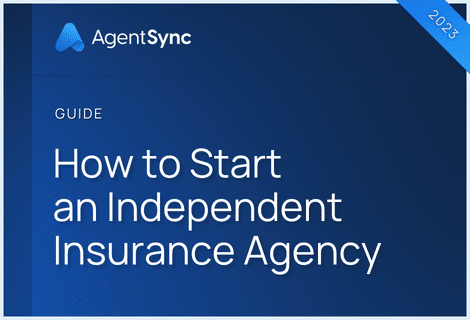

Welcome to insurance!
Are you just getting started on a career in insurance? Congratulations! Careers in this industry can be majorly rewarding. But trying to level up your knowledge can make you feel like the dog that caught the car: What do you even do?
If you’re looking for a way to get smart quick, we’re here to help. After writing hundreds of posts on insurance, we’ve learned a thing or two. Consider this our roadmap to help you learn more about the inside of the industry. This post focuses on the regulatory framework that gives insurance its guardrails and keeps everyone driving on the road, so to speak, and provides many opportunities for you to go down rabbit holes of knowledge so you can get as deep – or stay as shallow – as you need.
Understanding the business of insurance
If you are an adult in America, you likely understand the basic premise of insurance: An insurance carrier underwrites a risk, promising to protect the insured’s financial interests from that risk in exchange for premium payments.
There’s a lot of complicated stuff that happens beyond that, but that’s the foundation – it’s built on trust. Because consumers and businesses are placing so much trust in an insurance carrier, state and federal governments take their role of keeping the entire industry on the up-and-up very seriously.
There is, of course, also profitability to be had.
We’ll get into how products flow from carriers to consumers (otherwise known as the insurance distribution channel), but first, because we’re a bunch of pedants, let’s look at the way insurance is regulated.
How insurance is regulated
With a few exceptions, the federal government does not regulate insurance. The states do. And, as you might know if you’re a BBQ fan, things look very different from one state to another. That means everyone who wants to sell insurance has to worry about 50 states’ worth of regulation, plus territories and the District of Columbia:
Challenges of State-by-State Insurance Licensing Requirements
With 50+ jurisdictions weighing in on how to do things, basic aspects of compliance vary by state. For instance, there’s great industry disagreement over basic principles like what to call someone who engages in the business of licensed insurance sales. Are they an agent? A broker? A producer? It’s impossible to say:
Insurance 101: Insurance Agents vs. Insurance Brokers vs. Insurance Producers
The role of the NAIC and NIPR
Since there is little federal regulatory framework, there are a lot of entities that collaborate to form best practices and consensus in the industry. Chief among these is the National Association of Insurance Commisioners, (NAIC), which comprises all state and territory commissioners. The NAIC doesn’t make rules, but, since each state and territory’s insurance commissioners are members, the commissioners and other state regulators form working groups and task forces to draft model legislation that it hopes the states will adopt.
States often adopt NAIC model laws, but even then each state may add its own text or nuanced interpretations to the model laws. So, each state has its own regulatory culture and way of administrating, but the businesses and people who work in insurance often work across state lines. This makes for a somewhat frustrating time for the people who need to follow rules that change state to state, and it makes it hard for a company to establish a single set of operating principles:
Challenges of State-by-State Insurance Licensing Requirements
Members of the NAIC also form a board of directors that governs the National Insurance Producer Registry (NIPR), a nonprofit affiliate of the NAIC. This resource helps states share data about anyone who holds an insurance license. NIPR is key for the industry because it’s the most complete source of information from states for data like licensing, fees, appointments, etc.:
NAIC, NIPR, SILA, IIABA: Who They Are, What They Do, and Why They Matter
How AgentSync helps: AgentSync uses the ProducerSync API to draw data from NIPR and layer it into Manage or into a business’s CRM, as long as the business has a permissible purpose in using that data under the Fair Credit Reporting Act (Hint: Having compliance responsibility for a producer or adjuster constitutes a permissible purpose). Using other APIs, we can also send information back to the states via the NIPR Gateway. With our Manage product, we can then surface all producer licensing and appointment data to compliance teams and allow them to apply for new state appointments, new and renewal licenses, and submit contact change requests and information updates for producers. For businesses that want to be completely hands-off, we also have our Autopilot program, which is a managed service that uses Manage and APIs plus an internal team of superheroes at AgentSync.
How states regulate the various players in the insurance industry
We’ll get into the entities that play a role in insurance distribution in our next piece of the series, but the major players are carriers, agencies, and producers. Carriers make the policies, agencies connect carriers with producers, and producers sell policies to consumers.
Insurance carriers and certificates of authority (COAs)
Someone hoping to organize an insurance carrier in a state must file with the state department of insurance, and the process is often lengthy. Because states are responsible for ensuring the company remains solvent, there are many financial requirements:
Once a carrier has established a certificate of authority in a state, they may have many other requirements (getting a COA is relatively easy compared to keeping it in some states, and getting it is no walk in the park!). Many states require carriers to get preapproval on premium prices before they even offer products to consumers, and others require carriers to file annual reviews of things like:
- Geographical concentration of customers
- Customer data use
- Historical premium costs
- Disaster preparedness
- Climate change risks
Business entity (agency) state licensing
Agencies may have to apply for a firm-level producer license with a state, or they might not – it depends on the structure of the agency and the laws of the state. The agency may also have to file with the secretary of state. If you’re really interested, you can check out our guide to starting an independent agency:
New AgentSync Guide: How to Start an Independent Insurance Agency
Resident and nonresident producer state licensing
States require people who sell, solicit, or negotiate insurance policies to get producer licenses from the state. This typically involves the would-be producer sitting for an exam in the state they live in, their “resident state,” to get their license and taking continuing education every few years to keep it.
States regulate licensing based on a producer’s resident state, which may be where they live, or it might be where they work. States generally work on a system of “reciprocity,” meaning that, if you have passed the producer licensing exam in your resident state, then you can apply for a corresponding “nonresident” license in another state.
Some licenses seem straightforward to apply for across state lines. Others are difficult – for instance, pet insurance is something one state might require as its own special certification, while another state may allow anyone with a license to sell it as long as they have training through a pet insurance carrier.
How AgentSync helps: AgentSync layers state reciprocity into producer data, making it easier to apply for the appropriate reciprocal licenses for your producer’s target nonresident states.
There’s a lot to insurance, regulation, and compliance, but we’re here to help you get started. And, if what you need most of all is a partner that can help you better color in the lines, AgentSync’s got a suite of products and services to help you level up your compliance and producer management. If you’re interested, schedule a demo today.

